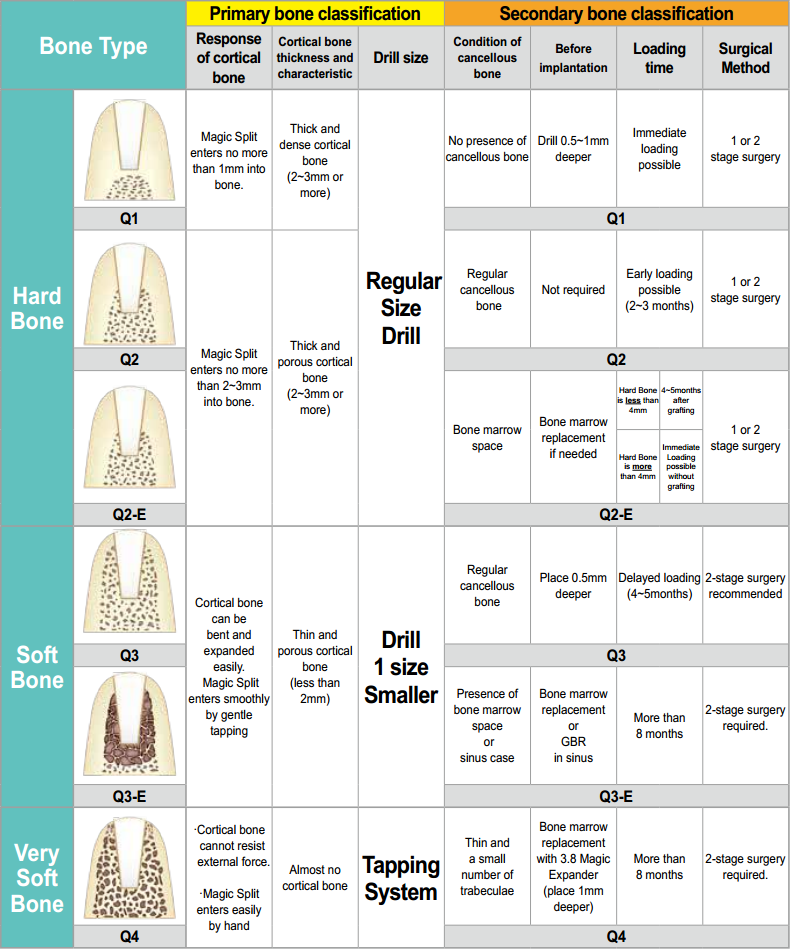Bone Quality Classification:
The InnoBioSurg Approach
Within the fields of surgery and dentistry, bones are organized into different types depending on their physical hardness.
There is hard bone, then soft bone, then very soft bone.
Carl E. Misch created the categories used to distinguish the various kinds of bone present within teeth.
In general, there are four types: D1, D2, D3 and D4.
D1 is very hard bone, while D2 is hard bone. Both are grouped under “hard bone”.
D3 is soft bone, while D4 is very soft bone. Both are grouped under “soft bone”.
To compare, in the case of D1, it is hard enough for flames to splatter when drilling, whereas in D4 it is weak enough for a fingernail to enter the interior when pressed on.
Depending on these characteristics, whether the implant is dental or surgical, and the size of the implant to be placed according to this bone classification, the procedure and the healing period vary.
IBS acknowledges the four categories previously created by Carl E. Misch, but has expanded upon their scope to accomodate outliers and other occurences in bone structure.
We took notice that D2 and D3 bones came in pairs. D2 and D2-E (the surface is D2, filled with soft bones), E means empty, along with D3 and D3-E (the surface is D3, filled with very soft bones).
Rather than using the existing D abbreviation, which stands for Density, we have opted to use Q, which stands for Quality.
Thus, we have come to recognize bones in terms of Q1, Q2, Q2-E, Q3, Q3-E and Q4.
The description of each type of bone, the method of operation, the surgical instrument, and the healing time according to the quality of the bone can be found on page 4 of the Surgical Manual.
Magic Split is used to identify the quality of the bone, and when you tap it with a mallet, or with the strength of your hand, you can make a primary diagnosis of the outer surface of the bone by looking at the extent to which the device is inserted.
After drilling, we use an Excavator to scrape the inside of the implant to establish a secondary diagnosis that identifies the hardness and durability of the tooth through the physical sensation.
Other companies often do not distinguish between surgical methods and implantation methods depending on the quality of the bone. IBS emphasizes that the quality of the bone must first be checked to ensure that the correct procedure is possible and that the surgical procedure must be differentiated.
Bone Quality Classification as used in Implant Treatment
The purpose of bone classification is to:
Determine the implant surgery procedure that ensures a high success rate.
Plan proper treatment for bone remolding that ensures a high success rate.
Effects of bone classification:
Determination of the placement hole formation method
Allows surgeons to decide on which surgical technique should be used (1-stage/2-stage surgery)
Predicts loading time

Dr. Wang’s Method
Primary diagnostic method
Both lateral blades of the ‘Magic Split ’should be aligned mesiodistally and entering direction of ‘Magic Split ’should be aligned with longitudinal axis of alveolar bone where implant is planned to be placed.
– Very soft bone: Bone condition with almost no cortical bone where ‘Magic Split’ enters by hand
– Soft bone: Condition of cortical bone that can be bent and expanded. Instrument enters by gentle tapping with mallet.
– Hard bone: Condition of cortical bone that cannot be bent. Does not enter more than 2mm by gentle tapping with mallet.
Secondary diagnostic method
Use Magic Depth Drill and perform drilling as if picking on and off at the bottom of the placement hole. If the bone permits the drill to do good grinding, it is cancellous bone; otherwise cortical bone. After this procedure, scratch the wall of the hole using the spoon excavator. If bone can be felt, it indicates the presence of cancellous bone. If the drill does not scratch but enters the wall, it is due to bone marrow spaces. Classify into Q1, Q2, Q2-E, Q3, Q3-E, Q4 according to the condition of floor and wall of the
placement hole.
– Cortical bone up to bottom floor: Q1
– Cortical bone with normal cancellous bone: Q2
– Cortical bone with bone marrow space: Q 2-E
– Thin cortical bone with normal cancellous bone: Q3
– Thin cortical bone with bone marrow space: Q 3-E
– Almost zero cortical bone and little cancellous bone: Q4
